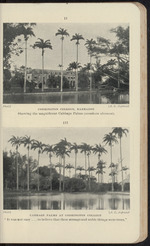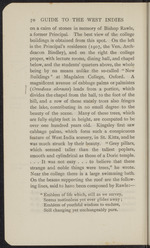| 1 |
 |
“...Photo]
[A. E. A spina ll
CODR1NGTON COLLEGE, BARBADOS
Showing; the magnificent Cabbage Palms ('preodo.ro, oleracea).
Photo]
\A. E. Aspinall
■I
CABBAGE PALMS AT CODRINGTON COLLEGE
** It was not easy ... to believe that these strange and noble things were trees.”...”
|
|
| 2 |
 |
“...the lake, contributing in no small degree to the
beauty of the scene. Many of these trees, which
are fully eighty feet in height, are computed to be
over one hundred years old. Kingsley first saw
cabbage palms, which form such a conspicuous
feature of West India scenery, in St. Kitts, and he
was much struck by their beauty. “ Grey pillars,
which seemed taller than the tallest poplars,
smooth and cylindrical as those of a Doric temple.
... It was not easy ... to believe that these
strange and noble things were trees,” he wrote.
Near the college there is a large swimming bath.
On the beams supporting the roof are the follow-
ing lines, said to have been composed by Rawle:—
“ Emblem of life which, still as we survey,
Seems motionless yet ever glides away ;
Emblem of youthful wisdom to endure,
Still changing yet unchangeably pure....”
|
|
| 3 |
 |
“...GRENADA
i65
man “of brutal manners,” who oppressed the
colonists to such an extent that he was tried and
condemned to be hanged. By pleading that he
was of noble origin he managed, however, to get
the sentence altered to beheading, but no skilful
executioner being available, he was at last shot at
the summit of the hill on the Grand Étang road.
De Cerillac sold the island again in 1665 to the
French West India Company, and on the dis-
solution of that organisation at the end of the
year 1674 it passed to the French Crown. It
remained in the possession of France until 1762,
when it capitulated to Great Britain, to whom it
was formally ceded in the following year. In
1779 it: was recaptured by a French fleet under
Count d’Estaing, but it was restored to Great
Britain by the Treaty of Versailles of 1783. The
year 1795 was a critical one in the history of
Grenada. In that year the notorious French
republican, Victor Hugues, made a determined
effort to regain possession of the island by bring-...”
|
|
| 4 |
 |
“...deep blue water dashes itself
into white foam. Proceeding round the island,
Sandy Point and Brimstone Hill are passed in suc-
cession. The next place which deserves a visit
is Middle Island Church, which shelters the tomb
of Sir Thomas Warner, the founder of the colony.
This great coloniser died at St. Kitts on the 10th
of March 1648, universally respected. His tomb
is inscribed:
“ First read, then weepe when thou art hereby taught,
That Warner lies interr’d here, one that bought,
With losse of noble blood, illustrious name
Of a Commander greate in Acts of Fame.”
The church is the parish church of Old Road, a
place which derives its name from the involuntary
exclamation of Columbus upon his second visit to
St. Kitts, “ Ah 1 we are at the old road again.”
NEVIS
Nelson's Island
The island of Nevis (Nievis, or Mevis, as it General
A onppt
used to be called in the old days) is separated
from St. Kitts by a narrow strait only two miles
wide, but from Basseterre, St. Kitts, to Charles-
town (population...”
|
|
